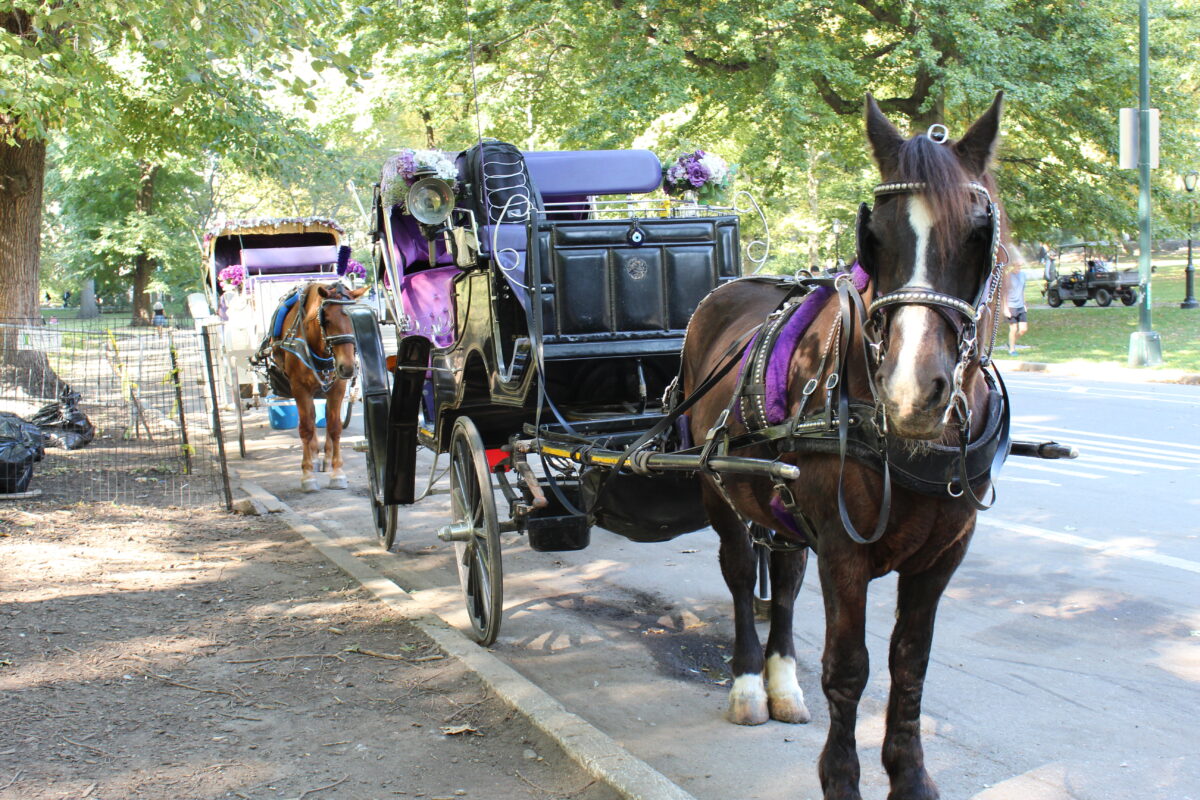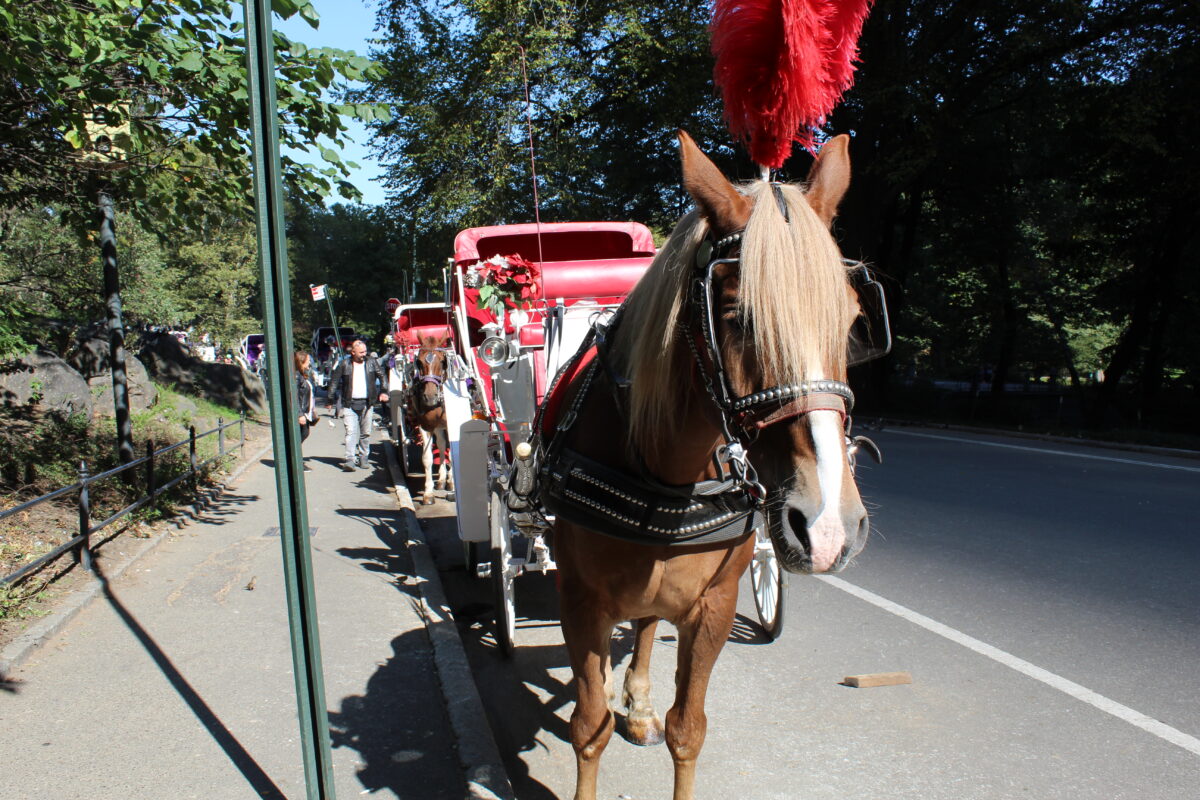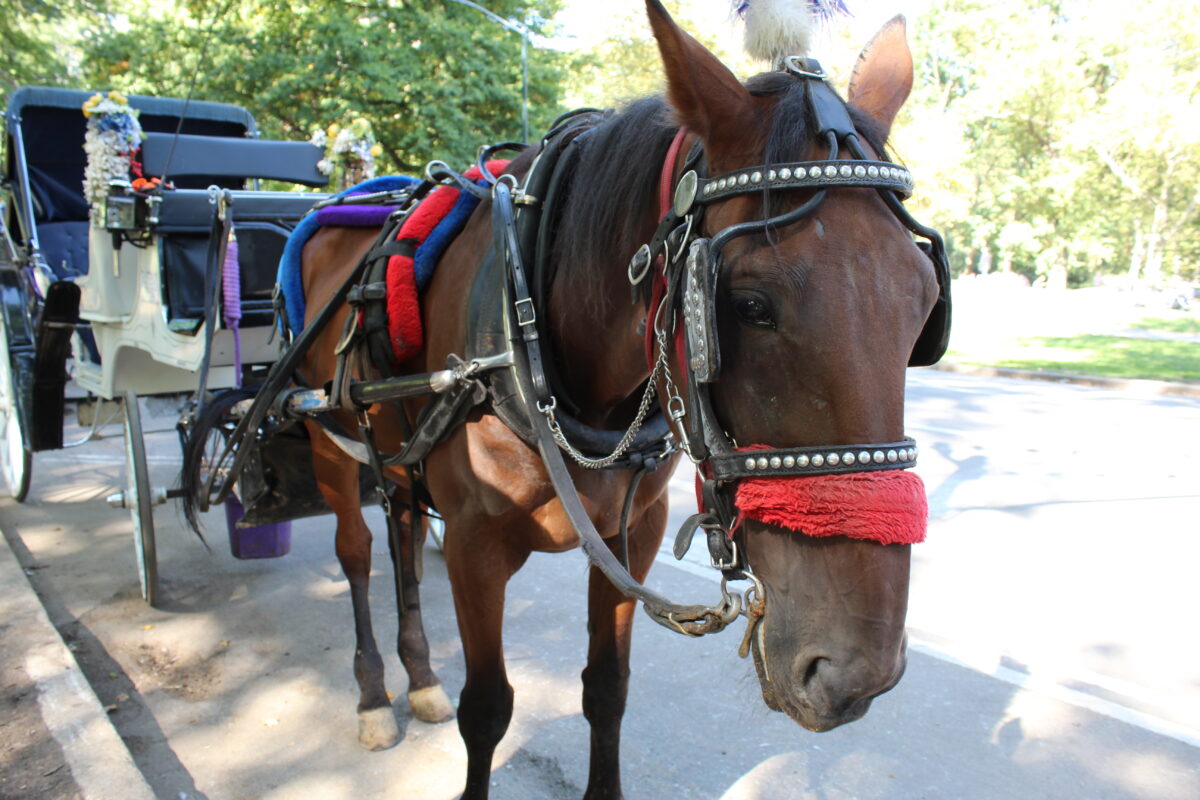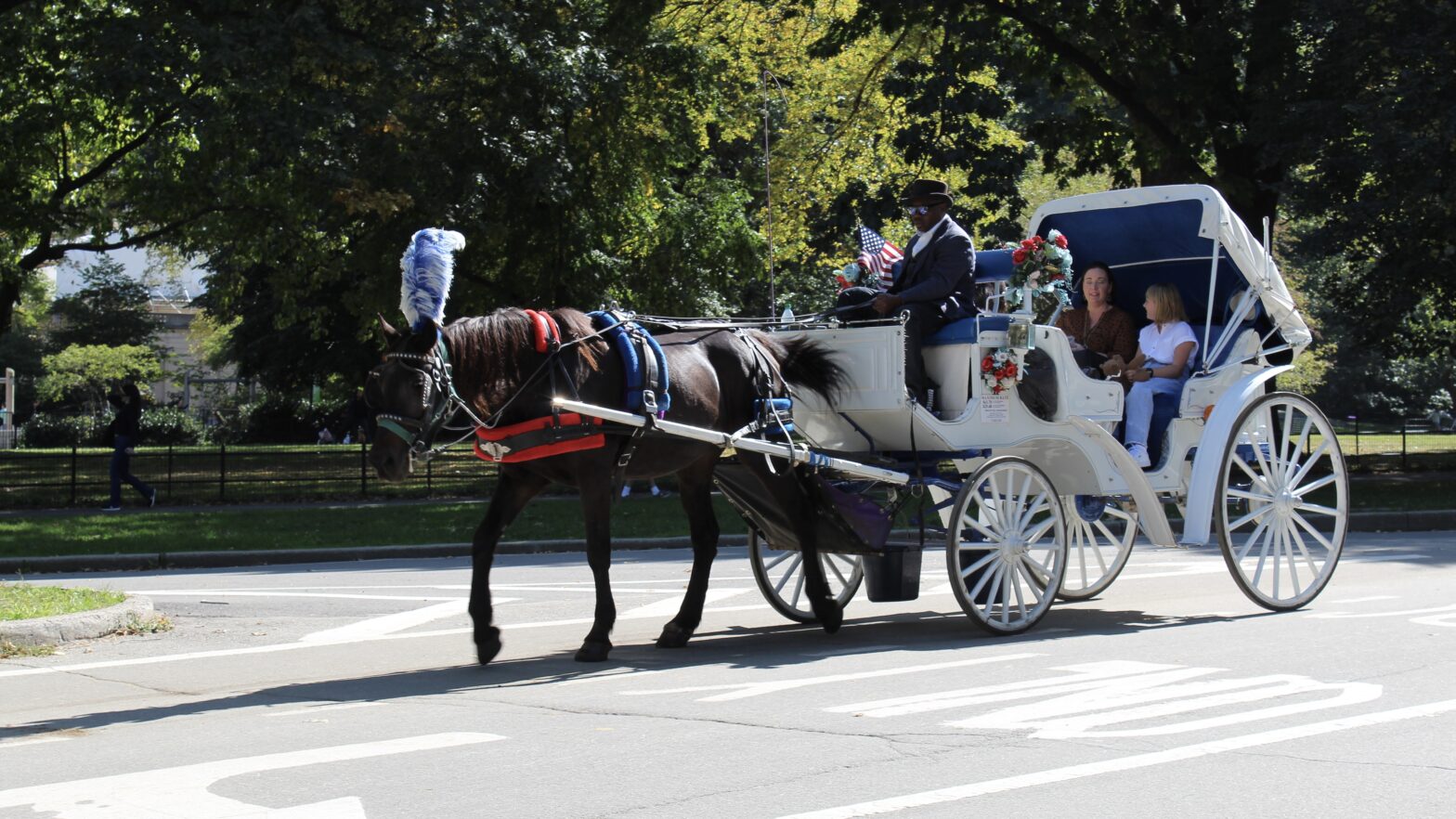Parks, politics, and ponies: The controversial world of New York City horse carriages.
It was a hot August evening when New York Carriage horse Ryder collapsed on Ninth Avenue surrounded by city buses and taxi cabs. Onlookers took videos as the horse laid in the street while his handler whipped and pleaded with him to get up. Ryder was later diagnosed with Equine Protozoal Myeloencephalitis, an infection caused by possum droppings. After regaining consciousness, he was relocated to a farm in upstate New York. On Oct 17 Ryder was euthanized after suffering from a seizure.
Ryder is not the only carriage horse to collapse in the concrete jungle. Aisha, a 12-year-old horse, collapsed in Central Park in February 2020. A 15-minute-long video of the incident shows the visibly distressed horse struggling to lift her head and stand. Aisha was forced into a trailer toward the end of the video. She was euthanized later that day.
As a self-proclaimed horse girl, Ryder’s death had an adverse effect on me. My love for the animal started at age seven following a summer of horseback-riding camp and a trip to see “Racing Stripes” in the movie theater. Frequent visits to my family’s farm in Ireland exposed me to the complex nature of these gentle giants. Over the years I’ve learned that no two horses are the same — each has its own personality, and they don’t forget you.
I decided to take the 5 train uptown to Central Park to investigate the treatment of carriage horses for myself. After several failed interviews, I began to think it would be easier to telepathically communicate with the horses.
“So, tell me about your life on the job?” I internally directed at a horse with an elaborate feather on its head. It did not respond. Instead, it proceeded to produce one of the largest bowel movements I had ever seen.

Photograph by Tara Lamorgese.
To my luck, I ran into Luigi, Pasquale – two horse handlers, and Shimmer, a 14-year-old Standardbred gelding. The drivers and horse have been assigned different names to protect their identities.
After some bargaining, Luigi and Pasquale agreed to take me on a 20-minute ride through the park for $60. Most rides cost roughly $110 for 40 minutes and are often tourist traps. I buried my pride, forked over what was left in my bank account, and hopped aboard.
Luigi and Pasquale are both immigrants from Italy. Luigi has been a driver for seven years. They told me that most New York City horse drivers are immigrants or first-generation Americans.
“I love horses. [This] is my dream,” Luigi said. “I grew up with the horses in Italy.”
As we passed the famous carousel seen in “The Producers,” I asked Luigi and Pasquale what their opinion was on people who view horse carriages as a form of animal cruelty.
Pasquale said that this narrative was introduced by NYCLASS, a non-profit animal rights organization founded in 2008 that opposes NYC carriage horses.
Edita Birnkrant, executive director of NYCLASS or New Yorkers for Clean Livable and Safe Streets, believes New York City carriage horses live in “abusive, dangerous, cruel conditions.”
“They are social animals,” Birnkrant said in an interview. “They’re meant to have access to turnout areas every day. Ideally, that would be a pasture but even if it’s not a pasture, a patch of dirt, something where they can move freely and be with other horses. They don’t have that in New York City.”
According to The Merk Veterinary Manual, horses that are unsocialized and routinely tied up can develop anxiety, claustrophobia, stress, self-mutilation, and compulsive swaying.
“I call it a life of 24/7 solitary confinement,” Birnkrant said.
Christina Hansen, carriage driver and 10-year Chief Shop Steward for union TWU Local 100, which represents horse carriage drivers and owners, argued otherwise.
“Horses are highly adaptable. They get used to what is normal noise wherever they’re at,” she said. “Our horses are walking many miles a day. They have an effective range over hundreds of acres here in Midtown and in Central Park, so they get a lot more space to move around than some horse in a little paddock some place in Long Island gets.”
I began to think about one of the ponies I rode as a child and how I used to put crumpled-up tissue inside his ears to ensure that he would not be spooked by the wind. I don’t think he would be successful in the Big Apple.
On the ride, Pasquale claimed that politics was a leading factor in NYCLASS’ objective. He said that the organization had close ties with former New York City Mayor Bill de Blasio, who strongly opposed the Central Park horse carriages because they are “inhumane”.
Birnkrant disputed this claim and said that de Blasio educated himself and drew his own conclusions.
I decided to do some digging.
I uncovered that NYCLASS spent $202,255 in the four days leading up to the 2013 mayoral election, where they openly endorsed de Blasio. When he entered office that same year, de Blasio promised to replace horse-drawn carriages with electric carriages, which he viewed as a safer and more ethical equivalent. This endeavor has been successful in Guadalajara, Mexico — “horseless” electric-powered carriages now roam the city streets.
Hansen alleges that freeing up stables for real estate development was initially a key factor in the fight against New York carriage horses.
“It doesn’t hurt their cause that [all] our horses live practically in the Hudson Yards… and we’re in the way of real estate development,” Hansen said.
Steve Nislick, president and co-founder of NYCLASS, previously worked as the Chief Executive Officer of Edison Properties LLC, a privately owned real estate holding and development firm holding properties in New Jersey and New York.
In recent years, the organization has taken on more of an activist approach.
De Blasio did not achieve his goal of electrifying carriages. However, he did aid in the passing of the 2019 Carriage Horse Relief Bill, which was signed by NYCLASS. The bill protects horses from working in extreme weather conditions.
NYC carriage horse defenders argue that replacing horses with electric cars is an erasure of culture. Horse carriage rides are a custom that has been around for centuries — watch any period piece with Kiera Knightley. Hansen and Pasquale believe that removing horse-drawn carriages from the park erases the city’s culture.
Horses have taken people on tours through Central Park since it opened in 1858. Wealthy New Yorkers frequented the park to show off their decorative horses and carriages. In 1863, carriage rides opened to tourists for 25 cents a passenger, according to IconicNYC.org. The service has been available through both World Wars and the Great Depression.
When the question of abuse was brought up, Pasquale vehemently denied the claim.
“There is no proof.”
However, allegations of abuse have been documented on the internet. Hansen categorizes these incidents, such as the one with Ryder, as outliers.
“We have about 200 licensed carriage horses and when you have 200 living beings, sometimes they get sick. Sometimes bad things happen to them,” she said. “You’ll never prevent things from never happening, but you can do your best. And we always try to do our best to ensure that our horses are safe and healthy.”

Photograph by Tara Lamorgese.
Birnkrant argued that the horses’ living conditions are poor.
“These are not like any stables you’ve ever seen,” she said. “They’re just like tenement buildings where the horses go up steep ramps to the second and third levels — that’s where their stalls are, which are about half the size of what is recommended for large draft horses.”
According to Equine Facility Design, a 12-by-16 stall is recommended for draft horses. The stalls in the Clinton Park Stables at 618 West 52nd St. are roughly 8-by-16 feet, as seen in a report from Untapped New York.
A Facebook video of the West Side Livery, the stable that Ryder lived in prior to his retirement, was posted by advocacy group, The Unbridled Heroes Project, in late August of this year. The person recording can be heard saying that the horses have “absolutely no room at all” in their stalls. Many of the horses appear to be underweight.
According to National Geographic, NYCLASS and other advocates believe that after they are retired, some carriage horses are sent to slaughter in Canada and Mexico.
Hansen said that the slaughter allegations are false and were created to further the animal-rights agenda.
“The reality is that we don’t send our horses to slaughter because, to be really blunt about it, our horses are too valuable,” she stated. “We’ve actually rescued horses that could have ended up at the auction… and so they’ve really kind of secured a future for themselves, so they’re gonna get good care.”
I suppose anything is better than ending up as dog food.
I asked Pasquale if Shimmer enjoys his job.
“He loves it.”
Toward the end of the ride, Shimmer was led across traffic so we could enter another part of the park. He seemed somewhat nervous as he walked alongside cars on Fifth avenue. I asked Pasquale if everything was ok as he went to check on Shimmer who refused to enter the intersection. He blamed it on bad drivers.
“Assholes, you know?”

Photograph by Tara Lamorgese.








Nice to see people investigating for themselves. Because behind every incident publicized by nyclass is a story untold and dismissed by Ms Birnkrant and her employer Nislick. The horse Aysha for example (press and activists spell her name incorrectly) was standing on an incline when she suffered her muscle illness which later required her to be euthanized. This incline was strongly protested as a waiting area for horses harnessed to carriages by city experts including veterinarians but because of the power of the mayors office, the move orchestrated by nyclass went ahead. I believe the stress from that incline caused Aysha to ultimately die. Ms Birnkrant called the equine opinion that an incline is inappropriate for a horse and carriage “manufactured hysteria.”
There are a lot of facts about this controversy. That every horse is suffering is not one of them.